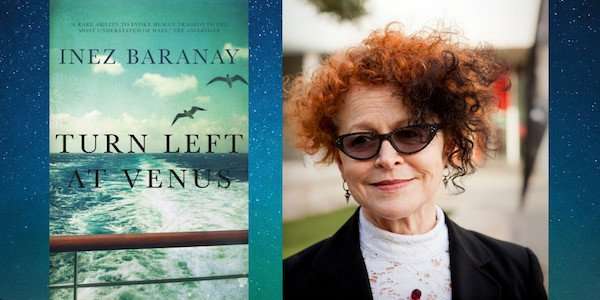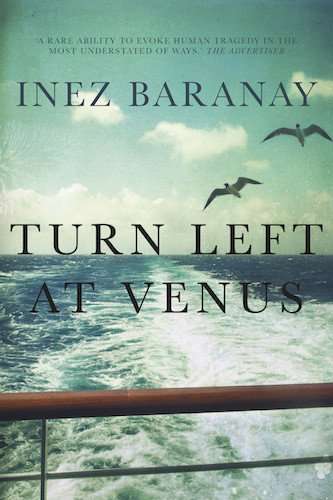Why Inez Baranay wrote TURN LEFT AT VENUS
Today we welcome Inez Baranay to Booklover Book Reviews to discuss her intriguing new novel Turn Left at Venus.

Turn Left at Venus Synopsis
They were two little girls on a very big boat.
In the 1930s, Ada and Leyla meet as children on a boat bringing migrants from Old Europe to the New World. They talk of seeing kangaroos yet end up living miles apart from each other in suburban Sydney. Their separations are often lengthy but their friendship endures across continents and decades and is a thread in this haunting story of writing, relationships and ageing.
Ada (A.L. Ligeti) becomes an author, searching for a Utopian world, exploring aspects of patriarchy and gender in her groundbreaking feminist science fiction novel called Turn Left at Venus. That novel and its sequels are celebrated and much discussed by generations of fans. Memory and imagination fold seamlessly into one another as Ada keeps moving on, from relationships and places, living in hotels and rental spaces in Kings Cross, San Francisco, Ubud and elsewhere.
Baranay’s emotionally resonant portrait of the solitary and artistic life, lived adventurously across space and time, triumphantly celebrates the singularity of being, of age, of imagination, and of the ‘getting ready’ for the ending that life demands.
‘A gripping treaty at the crossroads of fictive biography and speculative fiction about what it means to become old. Nothing is left untouched, unexplored: The life of the mind and the life of the body, inner space and outer space. It is a complex, magnificently written novel that replicates the way in which lived life and imagined life keep feeding each other.’ — Arianna Dagnino, author of The Afrikaaner and Transcultural Writers and Novels in the Age of Global Mobility
(Transit Lounge Publishing, October 2019)
Disclosure: If you click a link in this post we may earn a small commission to help offset our running costs.
Sign up to our Booklover Book Reviews emails and receive our gift for new subscribers. LEARN MORE >>
Why I Wrote Turn Left at Venus
After writing the novels Always Hungry (vampires in Amsterdam) and Ghosts Like Us (ghosts in Berlin) I wanted to write a third novel with a non-realist element. Not zombies not angels but how about aliens. Thinking about science fiction I had read swiftly sent me back to books by Ursula Le Guin, and other women writers of speculative fiction, and their links to ideas of utopia and anarchism, two longtime interests of mine.
Meanwhile I always wanted to write about female friendship in childhood and teen years — there is a kind of romance and intensity to youthful friendship, that can leave traces for a long time.
Also I wanted to write as an old woman about age. And to refuse the decline narrative, though noting the changes that age brings. In Turn Left Ada Ligeti, the main character, speaks too of joys and fun still to be had; she and her lover meet when they’re already old; they refuse to “complain and deplore” but are still curious and rejoice in discovery and advance … in age, the world is still intriguing, with much pleasure.
As I began to write Ada Ligeti’s life I needed to read some of the works that she wrote in her world — so I wrote bits of them, all a homage to women science fiction writers. And I was spending a lot of time online for long periods, lurking on boards and forums, sticking to the more well-mannered parts of the web, intrigued as always by how the language changes, how inventive new sayings and forms are. And so I began to write sections where Ada’s work was discussed, as it was rediscovered by new generations and written about in serious studies of popular fiction.
Then bit by bit it was clear to me that a few of the fans and academics on those boards and blogs would turn up in Ada’s present, part of a small crew gathered around on her deathbed.
 Turn Left at Venus also took me to various places I’d loved, this return doubly imaginative by going to them in eras before I had ever in real life reached there — Kings Cross in the 1940s, Ubud in the 50s, San Francisco in the 60s. I made Ada’s life one of constant relocation. This part of the novel threatened to take over as I spent time imagining Ada in several other wonderful locations, and what she would be writing there, and who she’d meet… but no, this would have turned the novel into a Big Fat Book and I wanted a short novel. I like novellas even better but this one needed full novel treatment, but it would not be an epic life story. Ada is dying and not every part of her life can be included in this story.
Turn Left at Venus also took me to various places I’d loved, this return doubly imaginative by going to them in eras before I had ever in real life reached there — Kings Cross in the 1940s, Ubud in the 50s, San Francisco in the 60s. I made Ada’s life one of constant relocation. This part of the novel threatened to take over as I spent time imagining Ada in several other wonderful locations, and what she would be writing there, and who she’d meet… but no, this would have turned the novel into a Big Fat Book and I wanted a short novel. I like novellas even better but this one needed full novel treatment, but it would not be an epic life story. Ada is dying and not every part of her life can be included in this story.
By this time it’s clear at least to me that the scenes from Ada’s life are to some extent filtered through her own memory — a direct memory of that time, or a memory of telling her lover about that time.
Also, I made Ada the kind of writer I never was: she only wrote in speculative fiction genre; she remained anonymous from the start, never giving interviews or appearances, and she made a lot of money from writing so she could always live how she pleased.
Still, ideal or even ideal-seeming lives are not entirely happy all the time.
Turn Left at Venus by Inez Baranay is available from:
Booktopia(Aus/NZ) | Angus&Robertson | Transit Lounge
About the Author, Inez Baranay
Australian citizenship, immigrant background, transnational culture, cosmopolitan temperament. Inez Baranay was born in Naples, Italy, grew up in Sydney. Australia. She has published twelve books of fiction and non-fiction, and has lived in and taught creative writing in countries including India, Indonesia and the United States. Most recently Inez taught at the university in Canakkale, Turkey, on the shore of the Dardanelles. She now lives in Sydney. More at www.inezbaranay.com
